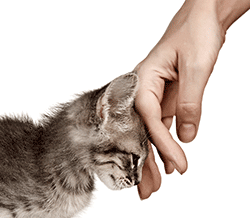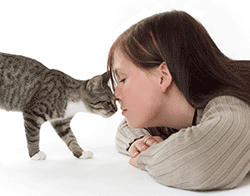Affection from your cat
Messages of affection from your cat are good indicators that you are bonding well and developing a positive relationship

Kneading
When very young, kittens 'knead' their mothers mammary glands to encourage the production of milk by alternately pushing and pulling with their front paws. A feeding kitten, safe and warm with its mother and litter-mates, is in a very contented and happy state, and a strong connection develops in the brain between the action of kneading and the feeling of contentment. Throughout a cats life this connection remains and whenever a cat feels very safe and contented, it often performs the kneading action. This instinctive behaviour is reinforcing and kneading releases endorphins which further increase the cats sense of pleasure.
Problem kneading
Cats generally knead only on soft surfaces and after some kind of stimulus, such as when being petted on their owners laps, or when sitting on a bed shared by their human companions. The degree of kneading depends on the individual cat and it can sometimes be painful for the human owner if it involves claws. Unfortunately there is little you can do to stop your cat from kneading and you should try and see it as a sign your cat is happy rather than a behaviour to try and stop. If its claws are causing pain, just try and move your cats paws gently, or put a cloth between your legs and the cats paws.
Purring
It is well known that a contented and happy cat will purr, but purring is not always a sign your cat is happy - cats will also purr when in distress or pain. This may be connected to theories that purring happens at vibrations at frequencies thought to be beneficial for good health. This might also explain why humans tend to react positively to purring - it is beneficial for us as well as the cat. Purring when in pain is said to be a deeper, more rumbling noise, and may be a sign that the cat is ready to accept help. In most cases, purring whilst being stroked is the cat's way of saying "I'm enjoying this and am happy"

Quiet times of affection with your cat are the best moments
Rubbing
There are several spots on your cats body where glands produce a scent carrying substance, and these are the spots where your cat will particularly enjoy rubbing on you. By doing this your cat is depositing scent and marking you as its property. In particular, most cats will rub with the sides of the face, top of the head, and base of the tail. Stroking these areas when your cat is in a good mood often results in a firm push back from the cat, a positive sign that it wants to be stroked and is showing affection. One of the strongest signs of affection from a cat is when it comes up to you and does a 'sideways headbutt' on your hand, leg, or face. This is your cat's way of saying "I like you and will mark you as my own"
Cat body language
Kneading, rubbing, and purring are quite bold statements of affection but there are also many more subtle indicators of a cat happy with your presence. Following you around the house and wanting to be in the same room as you is a good sign, as is 'greeting' you when you return home. Exposing vulnerable areas like the belly, or putting itself in a disadvantaged position (such as when coat cleaning) whilst in your presence is a good sign that your cat sees no danger in you and is fully comfortable. Cat's usually don't like being stared at, but if you happen to glance at your cat and it slowly closes or narrows its eyes, this is a sign of contentment and affection directed towards you. Some cat owners even go as far as to call these slow blinks 'kitty kisses' and you can reply to your cat be performing your own slow blinks back.
Mutual affection
Unlike dogs, which will bounce, bark, lick, and bound all over their owners, a cats display of affection is more subtle and refined. As you begin to bond with your cat you will learn your cats signals of affection, as well as its signals that it wants to be left alone. Your cat is also learning about you and the signals you give it, for instance that you don't like it when the rug is clawed, but quite like it when your lap is jumped on. Providing mutual affection is a good way of learning about each other, building and reinforcing bonds, and becoming part of the same family.


